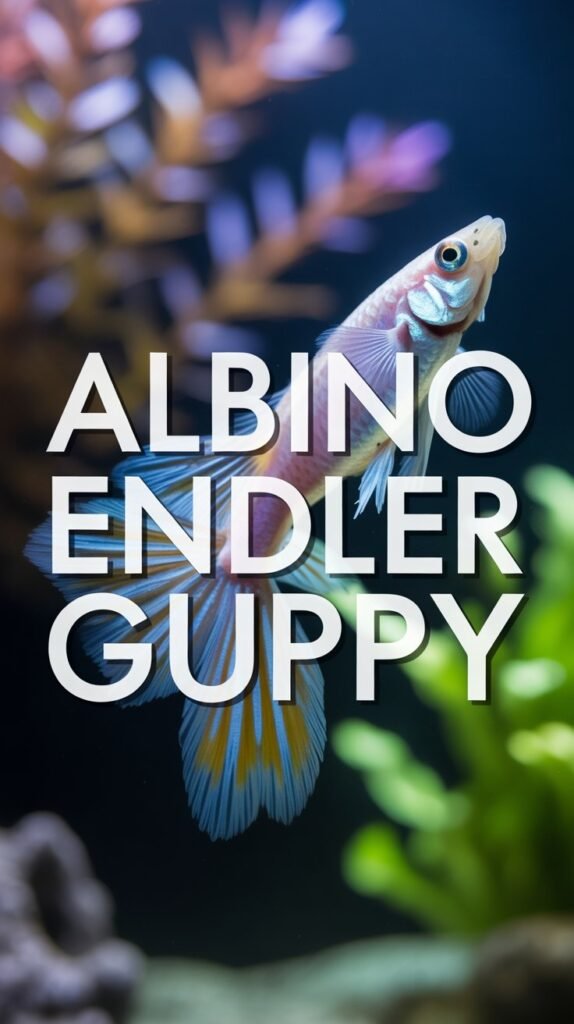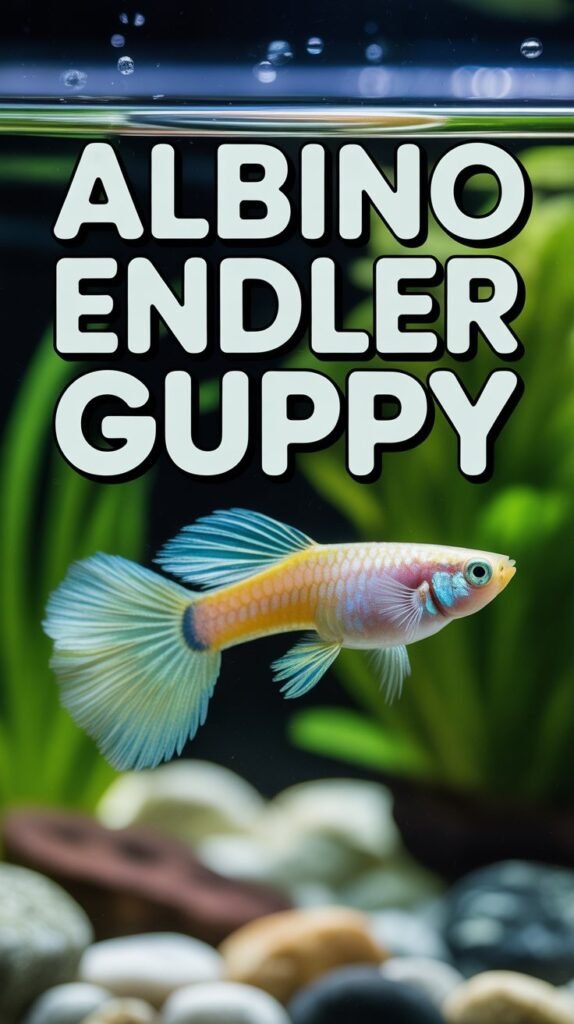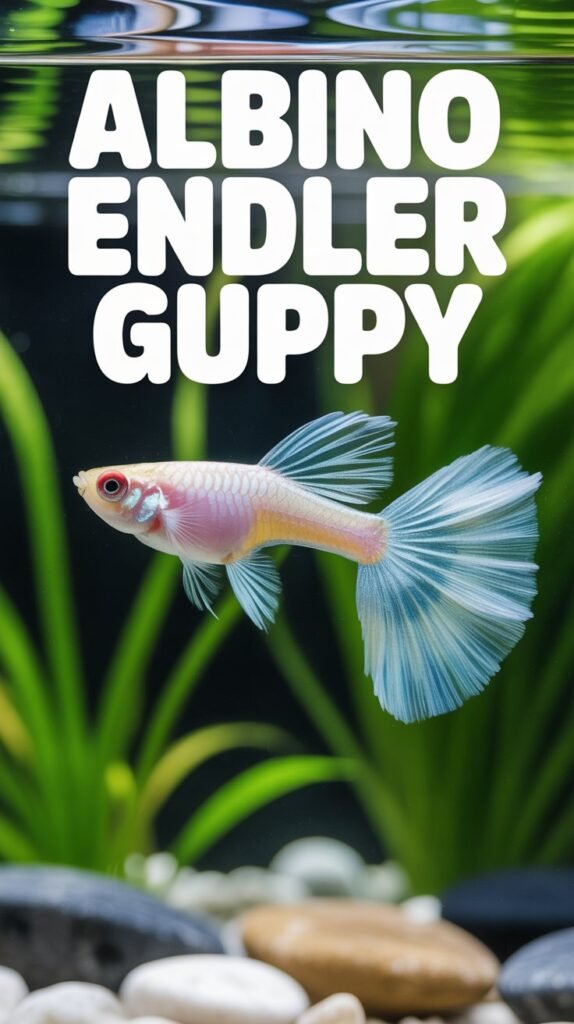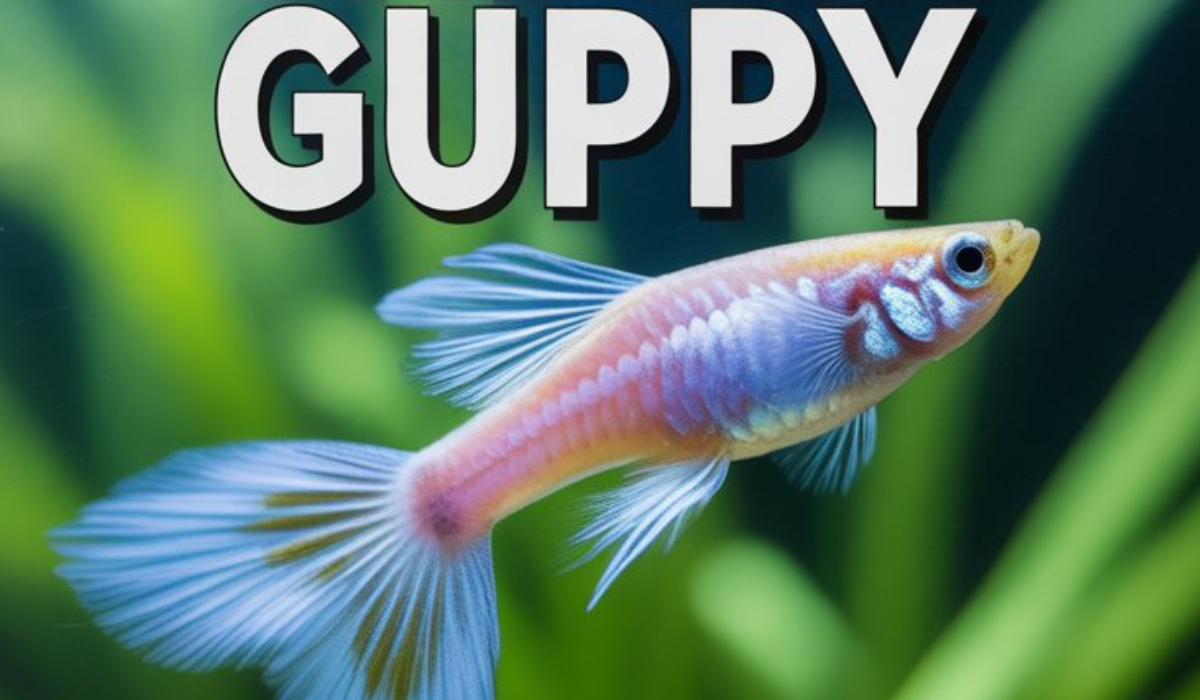Among the many beautiful livebearers in the aquarium hobby, the Albino Endler Guppy stands out for its delicate elegance and glowing coloration. Known for its pearly white to pinkish body and red eyes, this unique fish combines the charm of the classic Endler’s Livebearer with the rare genetics of albinism.
Small, active, and full of life, Albino Endler Guppies are perfect for both beginner and advanced aquarists. Their peaceful temperament, easy breeding habits, and shimmering color make them one of the most sought-after guppy varieties in the ornamental fish world.
In this comprehensive guide, we’ll explore everything you need to know about Albino Endler Guppies — including their origin, care, breeding, feeding, genetics, and how to maintain their stunning appearance.
Origin and Background
The Albino Endler Guppy is a selectively bred strain of the Endler’s Livebearer (Poecilia wingei), originally discovered in Laguna de Patos, Venezuela, in the 1970s. Endlers are closely related to common guppies (Poecilia reticulata), but they are considered a separate species due to their smaller size and distinct coloration.
What Makes Them “Albino”?
The albino trait is a genetic mutation that causes a lack of melanin — the pigment responsible for dark coloration. As a result:
- Their bodies appear light pink, white, or golden.
- Their eyes are red due to visible blood vessels.
- They often display delicate pastel colors instead of deep, dark hues.
Albino Endler Guppies are not found in the wild. They are the result of careful selective breeding by aquarists who combined albino genetics with the vibrant traits of Endler’s guppies.
Physical Appearance

The Albino Endler Guppy is a breathtaking fish that glows under aquarium lighting. Despite its small size, its unique features make it stand out in any tank.
Key Physical Traits
- Body Size: Males grow up to 1 inch (2.5 cm), while females reach around 1.5 inches (3.8 cm).
- Color: Translucent white to pinkish body with subtle orange, yellow, or blue iridescence.
- Eyes: Bright red, a defining albino characteristic.
- Fins: Semi-transparent, sometimes edged in light orange or golden tones.
- Shape: Slender, streamlined body typical of Endler’s Livebearers.
Varieties of Albino Endler Guppy
Through selective breeding, several color morphs have emerged:
- Albino Red Endler Guppy: Cream-colored body with vivid red fins.
- Albino Yellow Endler Guppy: Pale yellow-golden tones with red eyes.
- Albino Blue Endler Guppy: Subtle bluish iridescence across the body.
- Albino Mixed Endler Guppy: Combination of pastel shades creating a shimmering effect.
Each strain reflects the breeder’s artistry in enhancing color while maintaining the albino purity.
Male vs. Female Albino Endler Guppy
Male Characteristics:
- Smaller, more colorful, and slimmer.
- Possess a gonopodium (modified anal fin for reproduction).
- Display active courting behavior.
- Exhibit more vivid hues and patterns despite the albino trait.
Female Characteristics:
- Larger and rounder-bodied.
- Less colorful, typically pale white or translucent.
- Have a visible gravid spot when pregnant.
In an aquarium, the males’ continuous display of color and energy makes them the centerpiece of attention.
Behavior and Temperament
Albino Endler Guppies are peaceful, lively, and social fish that thrive in groups. Their small size and gentle temperament make them suitable for community tanks.
Behavioral Traits:
- Peaceful Nature: They rarely show aggression toward other fish.
- Schooling Fish: Prefer to stay in small groups of 5 or more.
- Active Swimmers: Constantly exploring the tank and displaying their fins.
- Social Dynamics: Males often engage in playful chasing and courtship dances.
These fish bring life and movement to aquariums, making them perfect for planted or nano setups.
Ideal Tank Setup for Albino Endler Guppy
Creating the right environment ensures your Albino Endler Guppies live healthy, stress-free lives while showcasing their best colors.
1. Tank Size
- Minimum Tank Size: 10 gallons (38 liters) for a small colony.
- Larger tanks (20–30 gallons) are better for breeding colonies or mixed communities.
2. Water Parameters
Albino Endlers are hardy but sensitive to poor water quality.
| Parameter | Ideal Range |
|---|---|
| Temperature | 72–82°F (22–28°C) |
| pH Level | 6.8–8.0 |
| Hardness | 8–12 dGH |
| Ammonia/Nitrite | 0 ppm |
| Nitrate | Below 20 ppm |
Maintain stable parameters to prevent stress and disease.
3. Filtration
- Use a gentle sponge filter or small internal filter.
- Avoid strong currents; Endlers prefer calm water flow.
- Clean filters regularly to maintain oxygenation and clarity.
4. Lighting
- Moderate lighting brings out their iridescent sheen.
- Too bright lighting can stress albino fish, so provide shaded areas with plants.
5. Substrate and Decor
- Fine sand or small gravel substrate.
- Live plants like Java Moss, Anubias, or Hornwort enhance the environment.
- Add driftwood, rocks, and caves for hiding spaces.
- Floating plants like Frogbit or Duckweed diffuse light naturally.
6. Tank Lid
Endler Guppies are known jumpers—always use a secure tank lid.
Diet and Nutrition
Albino Endler Guppies are omnivorous and have a varied appetite. A well-balanced diet ensures vibrant coloration and healthy breeding.
Best Food Options:
- Flake Food: High-quality guppy or tropical flakes.
- Micro Pellets: Small, slow-sinking pellets formulated for livebearers.
- Frozen Foods: Daphnia, bloodworms, and brine shrimp.
- Live Foods: Microworms, infusoria, or live brine shrimp for breeding adults.
- Vegetables: Blanched spinach, cucumber, and spirulina flakes.
Feeding Tips:
- Feed 2–3 times daily in small portions.
- Remove uneaten food after a few minutes.
- Supplement their diet with color-enhancing foods rich in carotenoids and vitamins.
Balanced nutrition enhances their subtle hues and boosts immunity.
Tank Mates for Albino Endler Guppy

Albino Endler Guppies are peaceful and coexist well with other calm species.
Compatible Tank Mates:
- Neon Tetras
- Ember Tetras
- Harlequin Rasboras
- Corydoras Catfish
- Otocinclus
- Cherry or Amano Shrimp
- Snails (Nerite or Mystery Snails)
Tank Mates to Avoid:
- Aggressive species like Barbs or Cichlids.
- Large predatory fish.
- Fin-nipping species such as Tiger Barbs.
Always choose community fish that share similar water parameters and temperament.
Breeding Albino Endler Guppies
Breeding Albino Endler Guppies is simple and rewarding. These fish reproduce easily in well-maintained aquariums.
1. Breeding Setup
- Use a 10–15 gallon breeding tank.
- Maintain temperature around 78–80°F (25–27°C).
- Add dense plants or breeding grass for fry protection.
- Keep a ratio of 1 male to 2–3 females.
2. Courtship and Mating
Males perform elaborate dances to attract females. Once mating occurs, the female can store sperm for multiple broods.
3. Gestation Period
- Typically 3–4 weeks, depending on temperature.
- The female’s abdomen becomes rounder, and a faint gravid spot appears.
4. Birth and Fry Care
- Each brood can produce 10–30 fry.
- Remove the female after giving birth to prevent fry predation.
- Feed fry with infusoria, crushed flakes, or baby brine shrimp.
- Perform small water changes frequently to maintain cleanliness.
5. Growing the Fry
Within a few weeks, fry grow rapidly and begin showing pale colors. By two months, males start developing distinct coloration and gonopodiums.
Breeding Albino Endler Guppies is an enjoyable process, and many aquarists selectively breed to refine coloration or body shape.
Genetics and Coloration
The albino trait is recessive, meaning both parents must carry the gene for offspring to display albinism. Albino Endler Guppies often exhibit:
- Lack of dark pigmentation (melanin).
- Enhanced pastel hues.
- Red eyes due to visible blood vessels.
Because albinism can slightly reduce visual sharpness, these guppies rely more on their other senses and gentle tank environments.
Selective breeding projects often combine albino genetics with color strains like red, yellow, or blue to create new morphs.
Health and Disease Prevention

Although hardy, Albino Endler Guppies require stable conditions and clean water to stay healthy. Their lighter pigmentation can make them more sensitive to bright light and poor water quality.
Common Health Issues:
1. Fin Rot
- Cause: Bacterial infection from dirty water.
- Prevention: Maintain hygiene; treat with antibacterial medication.
2. Ich (White Spot Disease)
- Symptoms: Tiny white dots on the body and fins.
- Treatment: Gradual temperature increase and anti-parasitic treatment.
3. Fungal Infections
- Appearance: White cotton-like patches.
- Treatment: Use antifungal medication and improve water conditions.
4. Swim Bladder Disorder
- Cause: Overfeeding or poor diet.
- Treatment: Feed smaller portions and fast the fish for a day.
5. Stress-Related Issues
Albino fish can be more light-sensitive—avoid intense lighting and sudden changes in water parameters.
Preventive Measures:
- Perform 25–30% weekly water changes.
- Avoid overcrowding.
- Quarantine new fish before adding to the main tank.
- Keep lighting soft and diffused.
Healthy Albino Endler Guppies swim actively, display bright eyes, and show no signs of fin damage or lethargy.
Lifespan
With proper care, Albino Endler Guppies live 2 to 3 years on average. Providing consistent water quality, balanced nutrition, and low stress ensures they reach their full lifespan.
Aquascaping Ideas
Albino Endler Guppies look best in natural, planted aquariums that highlight their delicate colors.
Recommended Plants:
- Java Moss
- Anubias Nana
- Amazon Sword
- Hornwort
- Vallisneria
- Floating plants for shade
Design Tips:
- Use a dark substrate to enhance their pale bodies.
- Include driftwood and rocks for contrast.
- Ensure open swimming areas in the center.
- Moderate lighting creates a beautiful soft glow on their scales.
An elegant aquascape complements their ethereal beauty and promotes calm behavior.
Albino Endler Guppy vs. Regular Endler Guppy
| Feature | Albino Endler Guppy | Regular Endler Guppy |
|---|---|---|
| Color | Pale, white, or pastel hues | Bright metallic colors |
| Eyes | Red | Black |
| Melanin Pigment | Absent | Present |
| Sensitivity | More light-sensitive | Hardy in strong lighting |
| Rarity | Less common | Widely available |
| Genetic Type | Recessive albino gene | Normal pigmentation |
Both are equally active and peaceful, but the Albino Endler Guppy offers a more delicate and unique beauty.
Tips for Keeping Albino Endler Guppies Healthy
- Maintain Stable Water Conditions: Avoid temperature and pH swings.
- Feed a Balanced Diet: Include protein, fiber, and color-enhancing food.
- Avoid Overcrowding: Provide ample swimming space.
- Use Gentle Lighting: Diffuse light to prevent stress.
- Perform Regular Maintenance: Clean filters and change water weekly.
- Monitor for Disease: Act quickly at the first sign of illness.
- Encourage Plants: They provide cover and improve oxygen levels.
- Separate Fry: To protect them from being eaten.
By following these simple steps, your Albino Endler Guppies will thrive and display their ethereal glow beautifully.
Why Choose Albino Endler Guppy?
- Unique Appearance: Their red eyes and pale, glowing bodies are mesmerizing.
- Peaceful Nature: Ideal for community aquariums.
- Easy to Breed: Perfect for beginners and breeders alike.
- Compact Size: Suitable for nano tanks.
- Active and Hardy: Constantly swimming and exploring.
These qualities make them one of the most captivating and rewarding livebearers to keep.
Conclusion
The Albino Endler Guppy is a graceful, luminous gem of the aquarium world. With their peaceful temperament, stunning pale hues, and easy care requirements, they bring elegance and tranquility to any aquatic environment. Whether you’re breeding them for their genetics or simply admiring their beauty, these fish never fail to impress.
By maintaining clean water, providing a nutritious diet, and ensuring a comfortable setup, you can enjoy the glowing presence of Albino Endler Guppies for years. Their charm lies in simplicity, purity, and natural grace — making them a true treasure in any aquarium.
FAQs About Albino Endler Guppy
1. Are Albino Endler Guppies natural or man-made?
They are selectively bred by aquarists through controlled breeding, not found in the wild.
2. What causes the albino coloration?
A lack of melanin pigment due to a recessive genetic mutation gives them their pale color and red eyes.
3. How big do Albino Endler Guppies get?
Males reach about 1 inch, and females can grow up to 1.5 inches.
4. Can Albino Endler Guppies live with other guppies?
Yes, they coexist peacefully with other Endlers or guppy varieties.
5. Are Albino Endler Guppies suitable for beginners?
Absolutely! They are hardy, adaptable, and easy to care for.
6. Do Albino Endler Guppies need special lighting?
Soft or moderate lighting is ideal since they can be sensitive to bright light.
7. What is the lifespan of Albino Endler Guppies?
Typically 2–3 years with proper care.
8. How often do they breed?
Females give birth every 3–4 weeks, producing 10–30 fry each time.
9. Do Albino Endler Guppies eat their fry?
They may occasionally eat fry; providing plants or hiding spaces helps increase fry survival.
10. What is the best food for Albino Endler Guppies?
A mix of flakes, live food (brine shrimp, daphnia), and spirulina-based foods ensures balanced nutrition and healthy growth.

